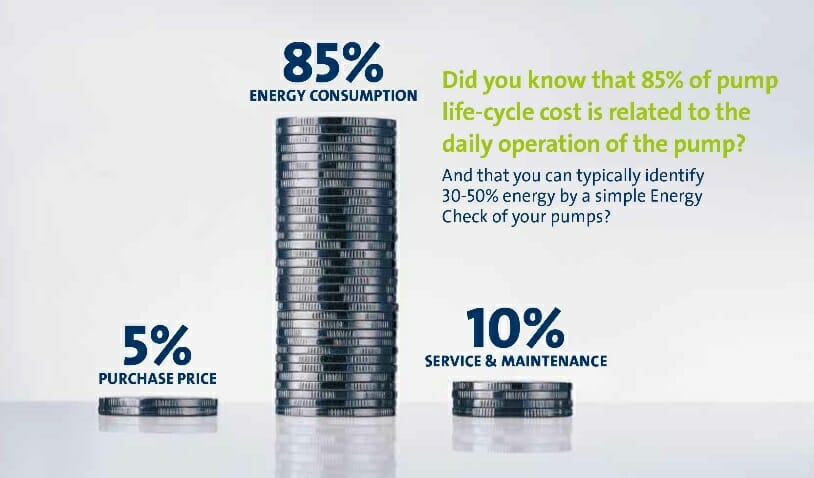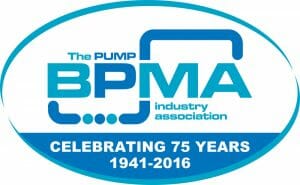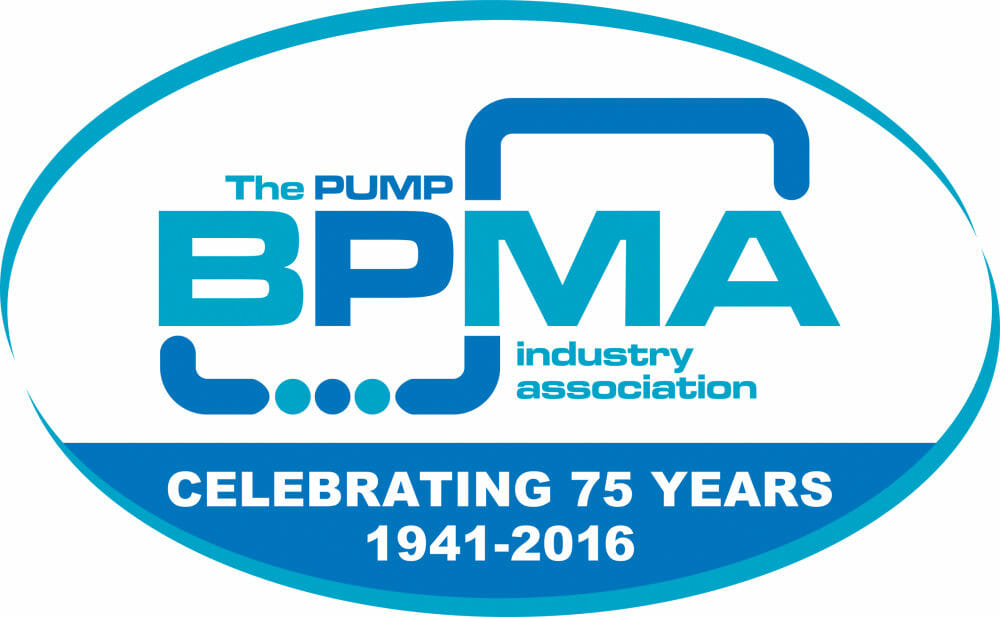When it comes to specifying pumping equipment, many companies, particularly those under increasing pressure to cut costs, could actually be making decisions that will cost them more in the long run. In this article, Steve Schofield, Director and Chief Executive of the British Pump Manufacturer’s Association (BPMA), explains how lifecycle costing can help to reveal the true cost of a pump.
The need to cut costs wherever possible is an increasingly familiar requirement for engineers charged with ensuring the continued smooth operation of plant on a limited budget. When it comes to pumping systems, although choosing the lowest cost option may seem like the best short term solution to achieving cost savings, it will almost always result in additional costs being incurred that could have been avoided by spending a little more time and money during the specification and design stage.
 According to statistics from the US Department of Energy’s Office of Industrial Technologies, pumping systems can account for between 25 and 50% of the total energy consumed by certain industrial processes. Add to this the need for ongoing service, repairs and maintenance throughout a typical service life of 20 years and pumps quickly begin to represent a substantial area of expense.
According to statistics from the US Department of Energy’s Office of Industrial Technologies, pumping systems can account for between 25 and 50% of the total energy consumed by certain industrial processes. Add to this the need for ongoing service, repairs and maintenance throughout a typical service life of 20 years and pumps quickly begin to represent a substantial area of expense.
The expectations of some pump users can be unrealistic when it comes to the cost of pump ownership, in many cases they focus too much on initial outlay, opting for the least cost alternative, which is not always actually the best solution for the application.
So what is the answer? The BPMA and many of its members are keen to emphasise the importance of life cycle costing (LCC) as a vital part of any pump purchasing and ownership strategy. Life cycle costing takes into account many factors, all of which impact on the total cost of owning and operating a pump, which includes much more than just the initial outlay.
A pump’s life cycle cost encompasses the total overall costs that accumulate throughout the life of a pump, from installation, energy consumption, operation, maintenance and down time, even environmental and through to the final decommissioning and disposal of the pump.
By carrying out an analysis of the costs that are likely to be incurred throughout the operational life of the pump, it is possible to objectively compare all the potential options at the outset.
Lifecycle costing can be useful not only for selecting new equipment but also for justifying the upgrade of existing systems. Throughout the lifetime of a pumping system, it is unlikely that the same operating conditions will continue to prevail.
Factors such as the addition of new equipment upstream of the pump or changes in production techniques can all cause variations in pump duty away from the pumps ‘Best Efficiency Point’ (BEP). This is the point where pump capacity and head pressure combine to provide the maximum efficiency performance from the pump. If the pump is incorrectly sized and is operating too far from the BEP, wear and tear can occur which can shorten its operational life.
An oversized pump, for example, will not only be inefficient, but will also cost more to maintain because operating too far to the left of its performance curve puts an extra strain on pump bearings and seals. On the other hand, a pump which is undersized for the duty may end up running too quickly, which may potentially ruin the product being pumped and also prematurely wear out parts of the pump. Also its efficiency will be affected, resulting in excessive energy consumption.
Although a pump should be sized to an application, achieving this is not always straightforward. Involvement of third parties and the need to meet possible changing future requirements can all affect the sizing of a pump. Over design on parameters is very commonplace.
If every party involved in specifying a pump adds on even a small percentage to their sizing estimate, the end result can be a highly inefficient pump. The extra cost, both in terms of running and maintaining the pump can be very high over the life of the plant.
One survey of 4,000 installations showed that water pumps typically operate with a shortfall in efficiency of between 12.5 and 20 per cent because they are incorrectly specified. The situation is worse for pumps that handle more unusual or complex media, such as chemicals or pharmaceuticals.
To help with changes in duty and assist with energy reduction many pump manufacturers are now promoting the use of Variable Speed Driven pump systems, frequency drive being the most prominent system used.
By using VSD’s you in effect combine electrical and mechanical principles.
The addition of the latest controls or ancillary equipment can often help boost efficiency and enable pumps to meet changes in demand at a fraction of the cost of building a new system from scratch. In some cases, simply upgrading a pumping system can result in energy savings of up to 50%.
The importance of good design
Maintenance and energy consumption represent by far the two most significant costs throughout the life of a pump. The answer to minimizing these costs lies in ensuring a well-designed pumping system, where the pump is specified as correctly as possible to the demands of the application. The energy consumption and efficiency of a pump is closely linked to the way that a pumping system is designed and operated.
Every pump manufacturer can, or should, supply characteristic curves for their equipment illustrating pump performance under given conditions. These curves demonstrate the inter-relationship between discharge capacity, pump head, power and operating efficiency.
The BPMA and its members have been involved in the writing of the following Europump guides to assist users with their selection and operation of pumping equipment:
| Europump – A Guide to system efficiency for rotodynamic pumping systems | £72.00 |
| Europump – A Guide to LCC Analysis for pumping systems | £83.00 |
| Europump – A Guide to Successful Applications for Variable Speed Pumping | £72.00 |
| Europump – Amazing discounts! (above 3 Publications) | £150.00 |
For further information, please also visit: https://www.bpma.org.uk/publications
Looking at the possible energy savings in the entire pumping system the BPMA in 2010 created the CPSA scheme (Certified Pump System Auditor). This is a new industry specific professional qualification developed by an established and highly regarded body within the industry.
The objective of the scheme is to help improve the levels of professionalism in the sector by creating a universally recognised and respected industry ‘standard’ for individuals assessing the performance of a pumping system.
The CPSA Scheme training includes:
- Pump System Requirements & Analysis considerations
- ISO 14414 Pump System Energy Assessment Standard Requirements
- Pump System Optimisation methods
- For further information please visit our CPSA website
How to get it right – some top tips from the experts
The following are just some of the key factors that should be considered when specifying a pump, which could help ensure it delivers optimum performance and economy throughout its service life.
- What sort of pump do you need?
There are many different types of pump available, each of which is suited to particular applications. The two most popular types are Centrifugal pumps and Positive Displacement pumps. Centrifugal pumps are generally suited to fast flowing or low viscosity liquid applications where the pressure is relatively constant. They perform most efficiently and cost effectively when operating at or near their Best Efficiency Point (BEP). Positive Displacement pumps, on the other hand, are particularly ideal for high viscosity applications, as they are better able to maintain a constant rate of flow.
It may also be necessary to consider what type of material the pump is manufactured from. Hygienic processes in the pharmaceutical or food and beverage industries, for example, are subject to the strict requirements of the Food and Drug Administration (FDA), which call for equipment to be manufactured from 316L stainless steel.
Information on selection and which pump is best suited /used on different applications can also be found within the BPMA buyers guide available on the BPMA website.
- Is there sufficient pressure for the pump to work effectively?
The efficiency and operation of centrifugal pumps in particular can be affected by the Net Positive Suction Head (NPSH) available. Basically, this is the amount of pressure that is required to prevent the liquid being pumped from vaporising inside the pump.
If the liquid vaporises, bubbles can be formed which will be carried into the pump. When these bubbles encounter zones of higher pressure in the pump, they will collapse violently, resulting in a phenomenon known as cavitation which can severely damage the pump.
When designing a pump system, it is essential to ensure that the available pressure on the pump inlet is greater than the pressure required within the pump to avoid the occurrence of cavitation.
- Is the pump positioned in the correct place?
Where a pump is positioned within a pipeline can also greatly affect its performance. As well as determining the amount of pressure available, the positioning of a pump can also affect the quality of the product being pumped. Too much or too little distance in the pipeline before the pump, for example, can lead to friction losses which can affect the flow rate of the substance being pumped, which in turn can affect the efficiency of the pump. The presence of pipe fittings, such as elbow joints, filters or other in-line equipment, can also affect the flow rate of a substance to the pump.
- Don’t just purchase on cost alone
When it comes to selecting a pump, cheapest is by no means best. Be particularly careful where reductions in the purchase price have been achieved by cuts in supplier back-up and expertise. Ultimately, the most cost-effective installation will be the one where the supplier can offer good technical back-up, an established track record and a reputation for high-reliability products based on sound research and development.
- Always take the pump manufacturers’ advice!
It’s surprising how many customers don’t take advantage of the expertise available from the pump manufacturer when it comes to ways of getting the best performance from their pumps. After all, nobody knows more about how to get the best out a pump than the company that built it.







